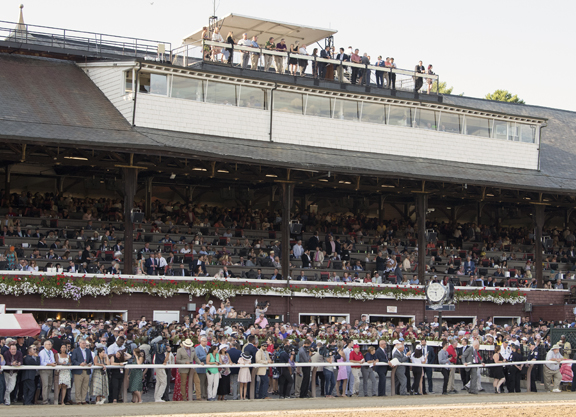By Bill Finley
As the calendar turned to mid-April, suddenly opening day at Saratoga doesn't seem that far off. The meet is set to begin in less than three months, on July 16. And while resuming racing at Belmont is of more immediate concern, it's not too early for the New York Racing Association team to begin to explore options for Saratoga, options that should include racing downstate throughout the summer.
That's assuming that NYRA is allowed to race at all. The only thing we know now is that Belmont will not open as scheduled Apr. 24. In an announcement that surprised exactly no one, NYRA made it official last week that racing would continue to stay on hiatus and did not set a new date for the Belmont opener. In early April, NYRA announced that Saratoga will open as planned, but, as developments with the coronavirus change by the day so, too, do the well-intentioned plans of those trying to make future schedules. Nothing is certain.
No one knows when New York racing will be allowed to resume and trying to predict when that will happen is pure guesswork. But as racing, and society, tries to figure out how to move forward while under attack from the coronavirus, the one thing that is fairly certain is that fans will not be allowed in the stands for the foreseeable future.
That would mean that if NYRA has been cleared to race come mid-July, the Saratoga meet might have to be held before empty stands. That's not Saratoga. Saratoga is a place where live racing not only matters, but is the pulse of the meet. The grandstand is normally teeming with life, young and old come to celebrate the horse and the entire town comes alive for six weeks. If you can't have fans, if the horses navigate around the track primarily so that people positioned in front of their computer screens have something to bet on, should you even have a meet? At the very least, that's something that NYRA needs to examine.
An empty Saratoga really wouldn't be any different than an empty Belmont. When the sport is stripped down to a made-for-television event, it really doesn't matter where the races are held. So, if Saratoga can't be Saratoga, wouldn't it be a lot easier on everyone involved with New York racing to stay put downstate?
Taking an entire community of racing people and transplanting them from Long Island to Saratoga is neither cheap nor easy. Hundreds of people have to be uprooted and find temporary homes. More than 1,000 horses have to be shipped out. Staying at home would mean a lot less hassle and it would have only a minimal impact on the Saratoga economy. If there are no fans in town and if the bars and restaurants are closed anyway, holding a live meet will do little for local businesses.
And could there be some related risks involving the coronavirus? It would seem that taking a large group of people and injecting them into a new community that has been trying to stay isolated would involve some health risks.
There are a handful of reasons to go to Saratoga anyway. It might be good for the collective psyche of the sport as canceling Saratoga, even a spectator-free Saratoga, would be depressing. The Saratoga brand should never be discounted and a Saratoga meet would likely handle more than a July-August Belmont meet, even if the racing is the same.
Then there is turf racing. The Belmont turf course gets worn down by the end of the meet and trying to get another six weeks of use out of it might be pushing things. Then again, if the Belmont spring meet doesn't begin until, say, June, that may be less of a problem. If the status of turf racing does become a problem, another option may be to head over to Aqueduct for a while and race over the two turf courses there that get only limited use.
These are tough questions and there are no easy answers. In a perfect world, Saratoga would not only open July 16, but would open up before a large and enthusiastic crowd ready to celebrate the return of racing. That's probably not going to happen, so a contingency plan is needed, even if that means saying see you next year to what is one of the sport's great meets.
Again, the Animal Rights Activists Have It All Wrong
In his story last week about the possible re-opening of Santa Anita, Dan Ross noted that a phone conference between track officials and Los Angeles County Supervisor Kathryn Barger was moved up to keep animal rights activists out of the loop and unable to interfere with the process. It wasn't the first time it has been reported that the animal rights crowd has gone out of its way to keep Santa Anita closed during the coronavirus. The hypocrisy is off the charts.
Anyone who cares about the animal should be doing the exact opposite, lobbying for racing to resume. Anything else could prove to be a major problem for the horses the PETA crowd claims to be so concerned about.
Even at Santa Anita, the horse population includes animals that will be put in increasing danger the longer the track is shuttered. With no racing, horses can't earn and horses that don't earn can become expendable. When an owner tells a trainer that he can no longer afford to pay the day rate to keep a horse in training, where does that horse go? It's not going to be to California Retirement Management Account (CARMA), which has announced that it can no longer take in retirees from Santa Anita because it has lost its main source of funding, purse contributions and matching funds during live racing.
The problem is worse at lower-level tracks, where many owners and trainers are having to deal with the harsh reality of what to do if someone can no longer afford to keep a horse in training. PETA, et. al., should be lining up behind those who are fighting to re-open the tracks because that is what is best for the horses. They would–if they actually cared more about the horse than an agenda to end horse racing.
The Remington Debacle
The Oklahoma Racing Commission's suspension of the Sooner 6ix wager at the Remington Park quarter-horse meet was a welcome development. Something needed to be done after horseplayer Jeff Arthur appeared to have taken home the entire jackpot pool Apr. 10 and the commission will now investigate. Arthur had the only ticket with all six winners, but didn't collect the whole pool because two of the horses he had in the last leg finished in a dead-heat for the win. That led Remington to declare that there were actually two winning tickets, albeit two belonging to Arthur, which meant the jackpot was carried over. Arthur received a consolation payoff of $8,920. Had it been declared that he was entitled to the entire pool, he would have won $35,145.
Remington wasn't entirely wrong. Going strictly on the rules of the wager, there were two winning tickets and the jackpot can only be paid out if there is a single winning ticket. But there should be a way to rely on simple common sense, which would dictate that Arthur deserved to be paid.
There's an easy solution to this: stick to the rules, but still pay Arthur as a goodwill gesture. Give him his $35,145, but keep the jackpot pool intact as if no one had a single ticket. That way everyone is happy and Remington can come out of this looking like the good guys rather than the track that stiffed a horseplayer out of what is rightfully his.
Not a subscriber? Click here to sign up for the daily PDF or alerts.






